Located in the interior of the Andalusian Autonomous Community, Córdoba is a compendium of past and modernity. This millennial city, declared a World Heritage Site, is a living legacy of the diverse cultures that settled in it throughout its history.
Few places in the world can boast of having been the capital of Upper Hispania under the Roman Empire and capital of the Umayyad Caliphate. This splendour is also palpable in the intellectuality of this centre of knowledge and knowledge that has given birth to figures such as Seneca, Averroes or Maimónides.
Walking around the old town of Cordoba means discovering a beautiful network of narrow streets, squares and whitewashed courtyards arranged around the Mosque-Cathedral, a reflection of the importance of the city in medieval times and an authentic symbol of the capital.
Not forgetting its splendid past, Cordoba is a modern city that has adapted to the present times to offer the most modern infrastructures and services, as well as a wide range of hotels.
Well communicated with the rest of Andalusian capitals, it has a high-speed train (AVE) and an extensive road network that brings it closer to large centres such as Madrid or Seville. And once inside the city, an extensive network of buses and taxis puts at the visitor's reach any destination in just a few minutes.
Córdoba is also synonymous with art, culture and leisure, thanks to the multitude of cultural events organized throughout the year: flamenco festivals, concerts, ballet... activities that are complemented by a good number of museums and a lively nightlife.
Meanwhile, the province hosts important samples of the Andalusian legacy, which has its greatest exponent in Medina Azahara, located on the outskirts of the city. But it also offers a great spectacle to nature lovers. The parks of Sierra de Cardeña in Los Pedroches and Montoro, Sierra de Hornachuelos and Sierras Subbética offer the possibility of practicing all kinds of outdoor sports, while allowing you to enjoy all the richness of this province.
Cordoba: Gastronomy
The way Cordoba is geographically located, there is a blend between the products of the Mountain and the flatland; the cuisine from “Sierra Morena” and from the “Guadalquivir” and the “Genil” valleys.
The Mountains supply raw materials, such as game hunting and live-stock breeding. The “Guadalquivir” valley provides the olive oil, the “Montilla-Moriles” and “Doña Mencía” wines, and a big variety of fresh vegetables and cereals. Since Cordoba is located between two seas, the Mediterranean and the Atlantic, it gives Cordoba the opportunity of getting always fresh fish.
Cordoba’s Gastronomical variety is really large. On one side, from the Roman conquest, Cordoba has a Mediterranean cuisine which means the use of olive oil and herbs. Another influence in Cordoba’s gastronomy is the Arab, as in other parts of Andalusia, cooking stewed vegetables that are a meal by themselves, not just an accompaniment of something else. The Arab influence also brought the sweet-sour tastes, the use of almonds, nuts and raisins with the meat and vegetable stews. The Jewish left some of their own dishes, like the “cazuela de habas secas con berenjenas” (dried beans and eggplant), “Gazpacho blanco de harina de habas”, etc.
The Christian conquest added their different ways of using and cooking the meat.
This mixture of gastronomic cultural influences, is well noticed with desserts. On one side you have “Mantecados” (small bread desserts made with pork fat) , “Perrunas”, etc., which are the Christian and Castilian heritage. On the other side you have “Alfajores” (dessert made with almonds, nuts and honey) and desserts made with almonds and sugar, which come from the Arab influence.
"Tapas" in Cordoba
A Tavern in Cordoba used to be a place where local people could go to drink wine. Every tavern used to have an interior courtyard (Interior "Patio") with a well, that was not only used to decorate but also to refresh the drinks.
In 1721 Cordoba already had more than 143 Taverns. Towards the end of the century, Cordoba had a song:
Cordoba, brave city, that between old an new, has three hundred taverns and only one bookshop.
Cordoba is one of the best towns for "Tapeo". You can find excellent "Tapas" at very plain bars and also at the very modern ones. There is a large variety of "Tapas"; but remember that here in Cordoba you can have the best "Flamenquines", "Salmorejo", "Rabo de Toro" (Bull's tail), "Eggplants with honey", etc. you will ever try.
If you want a few tips on what taverns to go to for a meal or a "Tapa", here we propose some of them: "Salinas" tavern, "San Miguel ", "Pepe el de la Judería", "La Viuda" (The widow) and of course "El Círculo de Plateros".
Monuments in Cordoba
-
Mosque Cathedral
-
Medina Azahara
-
Viana Palace
-
The Synagogue
-
The Alcazar of the Christian Kings
-
The Calahorra Tower
-
Cristo de los Faroles
-
Caballerizas Reales
-
The castle of Almodóvar
-
The Roman Mausoleums
-
The Roman Bridge
-
The Roman Temple
-
The Malmuerta Tower
-
Alminar de San Juan
-
The Monastery of San Jerónimo
-
La Judería
-
Cardinal Salazar Hospital
La Mézquita Catedral
C/ Cardenal Herrero, 1. - +34 957 47 05 12
The Mosque-Cathedral of Cordoba is one of the most important and peculiar monumental complexes in Spain and the West. It is an enormous Arab mosque to which false elements were added in Christian times, especially in the 16th century when the temple or Christian cathedral was built in a basically Plateresque style. The Mosque of Cordoba is not only the symbol of Al-Andalus, but a fundamental monument of the entire Islamic West and one of the most amazing in the world. It is the artistic reflection of the power of one of the most important political states of the West in the 9th and 10th centuries: the Emirate and Caliphate of Cordoba.
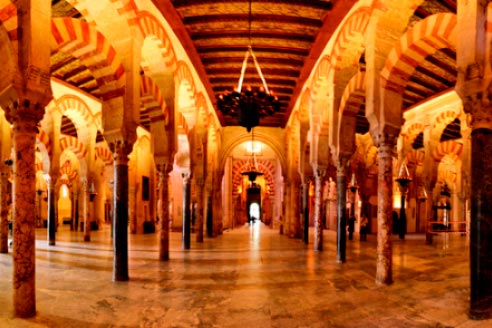
Medina Azahara

A 7 km oeste de Córdoba. - +34 957 35 55 06
Medinat al-Zahara, the magnificent and mysterious city that Abd-al Rahman III ordered to be built at the foot of the Sierra Morena, eight kilometres from the capital, contains, even in its name, legendary stories. Popular tradition states that, self-proclaimed Abd al-Rahman III caliph in 929 AD, and after eight years of reign, decided to build a palace city in honor of his favorite, Azahara. However, recent studies provide strong evidence of the cause that prompted the caliph to found Medina Azahara. A renewed image of the newly created Independent Western Caliphate, strong and powerful, one of the largest medieval kingdoms in Europe, is accepted as the most likely origin of the new Medina.
The UNESCO World Heritage Committee has included the city of Medina Azahara on the list of protected cultural sites on 1 July 2018, in a debate in which there were no objections.
Palacio de Viana
Plaza de Don Gome, 2. - +34 957 49 67 41
More than half of Reja de Don Gome Street is occupied by the rear facade of Viana Palace, whose main door is reached by surrounding the building. Originally dating from the 14th century, its current appearance is the result of a series of subsequent renovations. It is a civil construction from the medieval-modern period. It was declared a National Historic-Artistic Monument in 1981. The incomparable setting of its twelve courtyards and an imposing garden allows gardeners to enjoy the most varied selection of flowers.
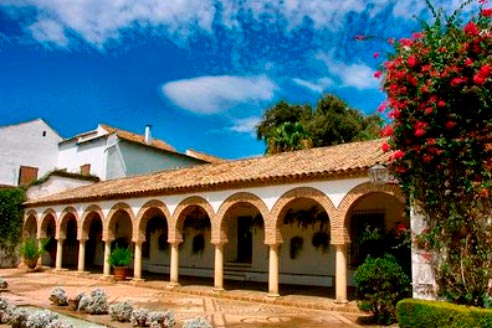
The Synagogue
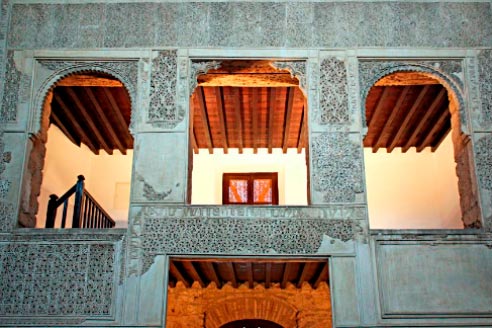
C/ Judíos. - +34 957 20 29 28
The Synagogue of Cordoba is one of the most significant in Spain along with those of Santa Maria la Blanca and the Transito de Nuestra Señora, both in Toledo. It was built, according to the founding inscription preserved inside it and whose translation is: Sanctuary in miniature and dwelling place of the Testimony (or Law) finished by Ishap Moheb, son of Mr. Ephrein Wadowa in the year seventy-five. Turn, O God, and hurry to rebuild Jerusalem! ... in the year 1315 (year 5075 of the Jewish calendar, which began on September 20, 1314 and ended on September 1, 1315).
The Alcazar of the Christian Kings
C/ Caballerizas Reales. - +34 957 42 01 51
A building of a military nature, it was built by order of King Alfonso XI in 1328. Gothic in style. It was the residence of the Catholic Monarchs for 8 years and where they received Christopher Columbus. It is a sober complex, with magnificent gardens and courtyards of Mudejar tradition. Built on the remains of other constructions, since since Roman times there was a walled enclosure with different buildings inside.
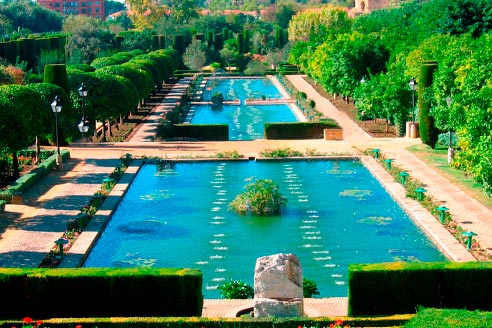
The Calahorra Tower
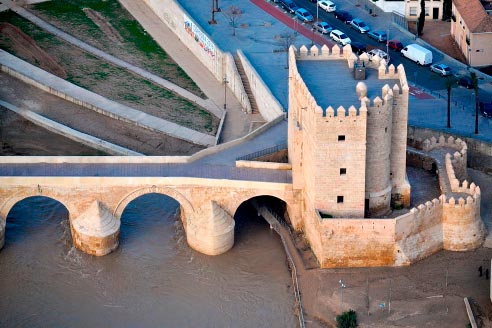
C/ Puente Romano s/n. - +34 957 29 39 29
Crossing the river, at the southern end of the Roman Bridge, stands Almodóvar Castle.
Of defensive origin, it consisted of two towers joined by an arch that allowed access to the city. Its current appearance, after successive and continuous modifications, dates from 1369 (reign of Henry II of Trastámara).
It was declared a historic-artistic monument in 1931, restored and fitted out in 1954, and was ceded to the Institute for the Dialogue of Cultures, which has installed an audio-visual museum with audio-guide techniques that have revolutionised the way people come into contact with history, images and objects.
Cristo de los Faroles
Plaza de Capuchinos y Cristo de los Faroles.
The Synagogue of Cordoba is one of the most significant in Spain along with those of Santa Maria la Blanca and the Transito de Nuestra Señora, both in Toledo. It was built, according to the founding inscription preserved inside it and whose translation is: Sanctuary in miniature and dwelling place of the Testimony (or Law) finished by Ishap Moheb, son of Mr. Ephrein Wadowa in the year seventy-five. Turn, O God, and hurry to rebuild Jerusalem! ... in the year 1315 (year 5075 of the Jewish calendar, which began on September 20, 1314 and ended on September 1, 1315).
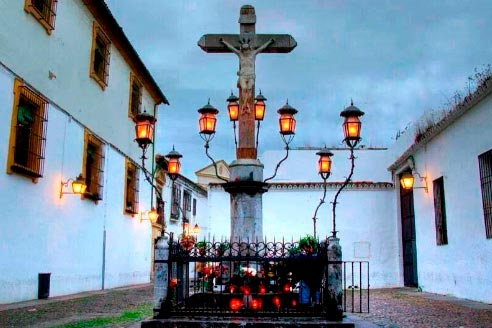
Caballerizas Reales
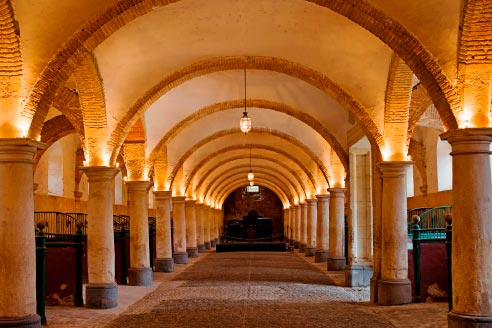
C/ Caballerizas Reales 1. - +34 902 20 17 74
In 1570, Philip II gave free rein to his love of horses and his project to create the purebred Spanish horse. To this end, he had the Royal Stables built on the former grounds of the Alcazar de los Reyes Cristianos.
The Spanish horse, also called the Andalusian horse, of Arabian descent, was bred here and is very much appreciated for riding.
The castle of Almodóvar
Calle del castillo, 14720 Almodóvar del Río, Córdoba. - +34 957 63 40 55
The castle of Almodóvar del Río is located 22 km from Córdoba, in the municipality of Almodóvar del Río, in the region of the Vega del Guadalquivir.
It is located on the top of a hill with a height of 252 meters and the total area of the fortress is about 5,628 m2. Almodóvar Castle is a fortress of Iberian origin and later a Roman castro, built by the Arabs in the year 760. It has undergone successive reconstructions, the most important in the year 1902 carried out by the Count of Torralva.
Traces of multiple cultures, such as the Muslim and Christian ones, have been marking the exquisite style of an incomparable setting. Discover the beauty of its walls, its square and round towers, its courtyard and the mystery of its dungeons, passages and underground.
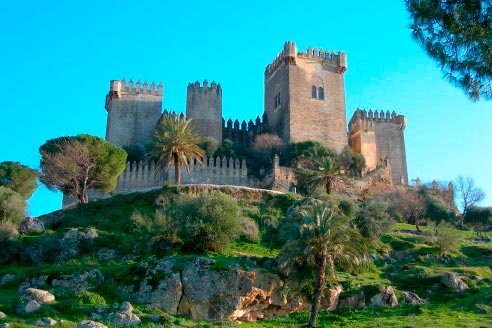
The Roman Mausoleums
Puerta Gallegos.
Located in the western Roman necropolis of Cordoba next to the road leading to Hispalis (Seville), this first-century burial site was discovered in 1993. It consists of a cylindrical building with an inner core of concrete covered with calcarenite ashlars.
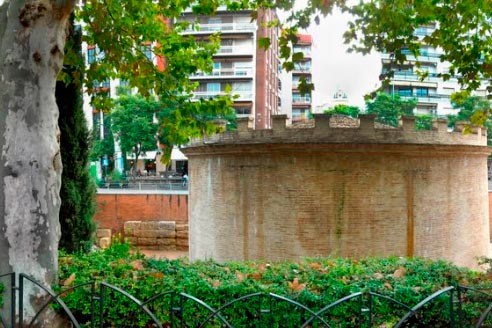
The Roman Bridge
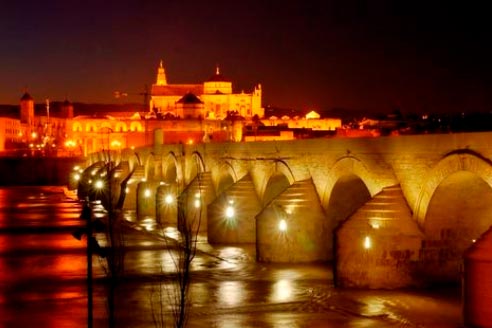
Puente Romano S/N.
Entre bajada del puente-ronda de Isasa.
The Roman Bridge of Cordoba is located over the Guadalquivir River as it passes through Cordoba, and links the Campo de la Verdad neighbourhood with the Cathedral Quarter. It is also known as the Old Bridge, as it was the only bridge in the city for twenty centuries, until the construction of the San Rafael Bridge in the mid-20th century. On January 9th, 2008, the largest and most controversial remodeling that the Roman Bridge has had in its history was inaugurated.
Since 1931, the bridge, together with the Puerta del Puente and the Calahorra tower, has been declared a Site of Cultural Interest in the Monument category.1 It is also part of the historic centre of Cordoba, which was declared a World Heritage Site by UNESCO in 1994.
The Roman Temple
C/ Claudio Marcelo.
Next to the Town Hall of Cordoba is the only Roman temple for which archaeological evidence has come down to us. Dedicated to the imperial cult, it is surprisingly large. It was part of the Provincial Comitium together with a circus.
It was originally raised on a podium and had six free Corinthian columns at its entrance. In front of it stood the ara or altar. The reconstruction, carried out by the architect Felix Hernandez, has brought to Cordoba another sample of the greatness of this city at Roman age. Some of the original pieces of the temple are on display in the Archaeological Museum or in unusual and beautiful corners of the city, such as the fluted column in the Plaza de la Doblas.
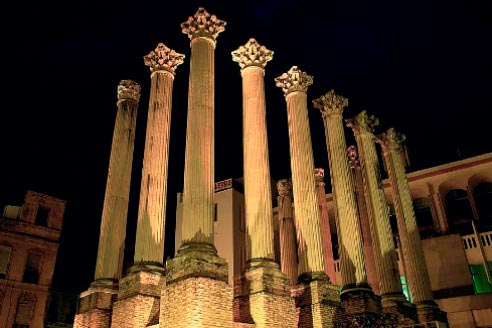
The Malmuerta Tower
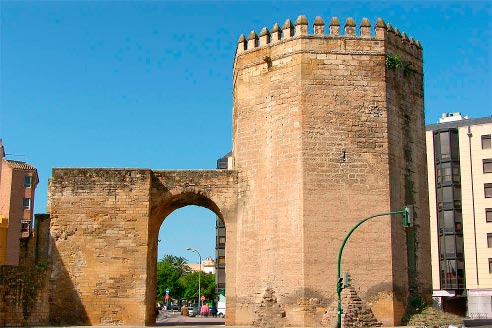
Plaza de Colón-Ollerías.
Due to the great distance from the Jewish quarter, this monument is not so well known to tourists. However, it is a unique example of the city's medieval architecture. This powerful octagonal tower was built in the early 15th century by Moorish workers and was part of the wall in the northern part of the city.
Inside, it has a single room that communicates with the outside through slim arrow slits and is topped by a dome of half an orange. The upper floor can be reached via a staircase. From there you have an excellent view over a large part of the farmhouse. Unfortunately, at present it is not possible to visit the interior of this monument.
El Alminar de San Juan
Plaza de San Juan.
This minaret is noteworthy for its almost complete Arab appearance from the tenth century, despite having been ceded after the reconquest, along with the mosque that housed it, for the construction of a church of the Order of St. John.
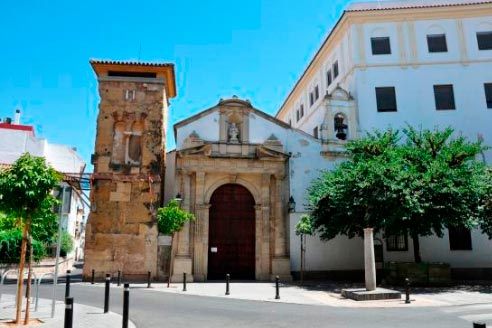
The Monastery of San Jerónimo
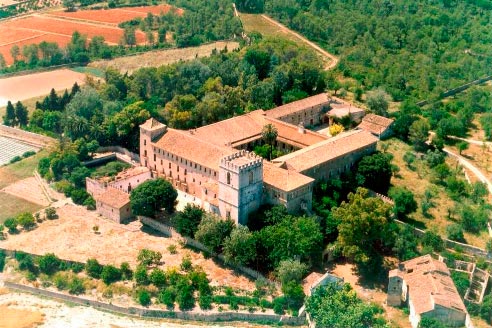
Carretera de Palma del Rio.
Opposite the impressive Medina Azahara, also sheltered by the Cordoba mountains, and surrounded by native vegetation, is this imposing 15th century monastery.
The Monastery of San Jerónimo de Valparaíso is the first work of the Cordovan Gothic.
Founded after the arrival of some monks, mostly from Portugal, in Cordoba and with the help of Ines de Pontevedra and her son, the warden of the Donceles, Martín Fernández, a monastery was established on the slopes of the Sierra Morena and near Medina Azahara.
On November 21, 1980, it was declared a property of cultural interest.
La Judería
Zona: Calle Romero, 10, 14003 Córdoba.
The walled enclosure known as the Castle of the Jewish Quarter is located in the city of Cordoba, capital of the province of the same name, bordering to the east with the enclosure of the Medina, to the west with the enclosure of the Alcázar Viejo, and to the south with the Alcázar de los Reyes Cristianos.
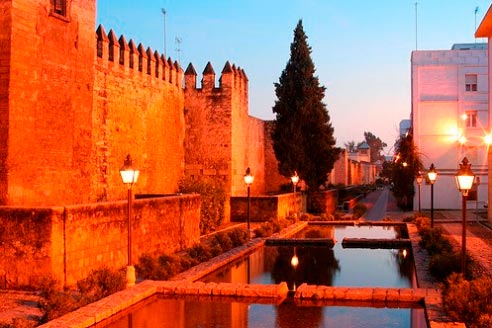
Cardinal Salazar Hospital

Pza. del Cardenal Salazar.
In the heart of the Jewish quarter Francisco Hurtado Izquierdo built the old hospital of Cardinal Salazar, also known as the Hospital de Agudos, today within the premises of the Faculty of Philosophy and Letters. It has an almost square floor plan, with an atrium and chapel, tiled bases and a paved courtyard. It is a complex that is a good example of the academic aesthetic. Inside is the Chapel of San Bartolomé.
Hotels in Cordoba
Opinions
El free tour con Jaime fue genial. Es una persona muy simpática y que supo explicar toda la historia de Córdoba de una forma muy amena y con muchas anécdotas. Súper recomendable.
Free Tour Córdoba
We had a brilliant guided tour whit Miguel José. He is highly knowledgeable and well read. We were a group of four people and he kept us engaged throut the tour. Highly recommended!
Free Tour Córdoba
Hicimos el free tour con David, fue verdaderamente interesante y su manera de explicar fue muy divertida. Lo recomiendo totalmente.
Free Tour Córdoba




